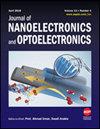Theoretical Study of Spontaneous Emission Spectra in GaAsBi/GaAs Quantum Wells
IF 0.6
4区 工程技术
Q4 ENGINEERING, ELECTRICAL & ELECTRONIC
引用次数: 0
Abstract
GaAsBi/GaAs heterojunctions have a type II band arrangement, and the band structure energy of GaAs alloys with diluted Bi content provides a wide range for designing effective band gaps. In this paper, we calculate the electronic energy band structure of GaAsBi/GaAs quantum wells (QWs) with different Bi concentrations under the 8-band K · P model. The calculated results show that the Bi concentration has a great influence on the band gap, valence band, conduction band, and other structures of GaAsBi/GaAs QWs. Based on the band structure, we make systematical simulations on the effects of different quantum well widths, different Bi concentrations, different carrier densities, and different temperatures on the spontaneous emission spectra (SES) of GaAsBi/GaAs QWs. We find that the peaks of SES reduce with the increase of temperature and well width of the quantum well structure. The full width at half maximum (FWHM) of SES at 300 K is 0.1 eV, which is much broader than that at 100 K. The increasing Bi concentration is found to give rise to the blue shift of SES. Finally, the carrier concentration in the quantum well is found to be an important factor that can enhance the SES peak values. The findings in this work are helpful in the design of GaAsBi/GaAs-based optoelectronic devices.GaAsBi/GaAs量子阱中自发发射光谱的理论研究
GaAsBi/GaAs异质结具有II型能带排列,稀释Bi含量的GaAs合金能带结构能为设计有效带隙提供了较宽的范围。本文在8波段K·P模型下计算了不同Bi浓度的GaAsBi/GaAs量子阱(QWs)的电子能带结构。计算结果表明,Bi浓度对GaAsBi/GaAs量子阱的带隙、价带、导带等结构有较大的影响。基于能带结构,系统模拟了不同量子阱宽度、不同Bi浓度、不同载流子密度和不同温度对GaAsBi/GaAs量子阱自发发射光谱(SES)的影响。我们发现,随着量子阱结构的温度和阱宽的增加,SES的峰值减小。SES在300 K时的半峰全宽度为0.1 eV,比在100 K时宽得多。发现铋浓度的增加会引起SES的蓝移。最后,发现量子阱中载流子浓度是提高SES峰值的重要因素。本研究结果对GaAsBi/ gaas基光电器件的设计具有一定的指导意义。
本文章由计算机程序翻译,如有差异,请以英文原文为准。
求助全文
约1分钟内获得全文
求助全文
来源期刊

Journal of Nanoelectronics and Optoelectronics
工程技术-工程:电子与电气
自引率
16.70%
发文量
48
审稿时长
12.5 months
 求助内容:
求助内容: 应助结果提醒方式:
应助结果提醒方式:


